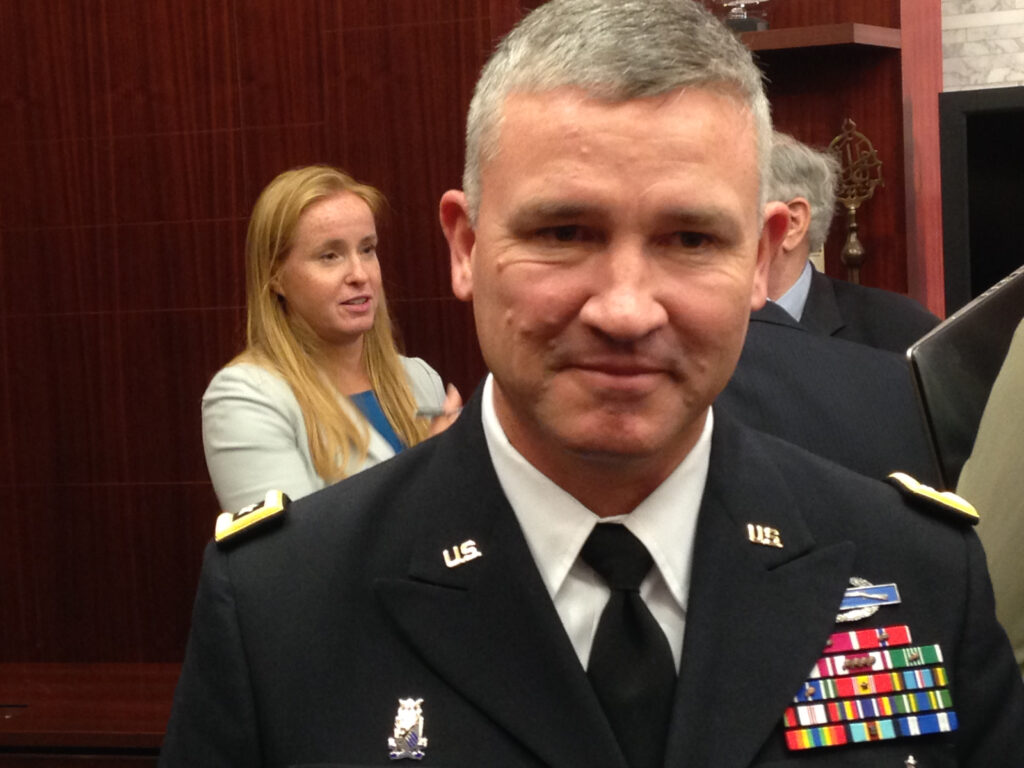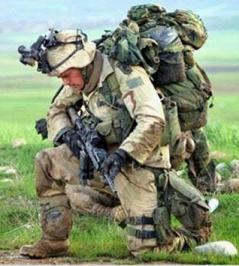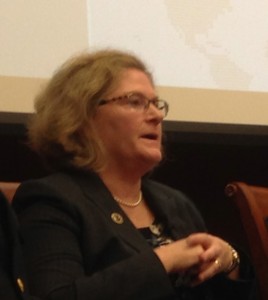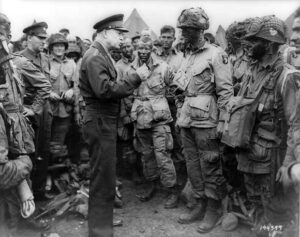Can The Army Get Its Bureaucratic Act Together?
Posted on

Army Maj. Gen. Robert Dyess (foreground) and CSIS scholar Maren Leed (background).
WASHINGTON: “Everybody’s got to change,” Army Gen. David Perkins told me last week. But can the biggest, most bureaucratic, and most fractious service really break a 12-year streak of cancelled multi-billion-dollar programs? It turns out the Army is already taking some important steps. A new doctrine and a long-range planning process instituted two years ago have begun to make real progress in breaking down barriers within the Army between budgeteers, acquisition officials, and — as of this year — the experts who write its doctrine and requirements at the Training and Doctrine Command (TRADOC), which Perkins heads.
“There has been real progress,” CSIS scholar Maren Leed believes. As recently as April, when Leed published a study on the struggle to synchronize the Army’s myriad programs to train and equip individual soldiers, “they didn’t have a common framework [or] shared vision,” she told me. Today, in large part thanks to TRADOC’s work on a new Army Operating Concept due out this month, she said, “there’s a much clearer sense of the future environment and a shared view of the future environment.”
What’s more, TRADOC is much more involved in this year’s Long-Range Investment Requirements Analysis (LIRA) process, which will inform the president’s budget submission for 2017, said Maj. Gen. Robert Dyess, the Army’s director of force development. In years past, TRADOC just briefed LIRA participants on future threats and needs. “That was usually a [single] briefing at the beginning of the LIRA,” he told reporters after a talk this morning at the Center for Strategic and International Studies (CSIS). “This time, this year, they’re going to be in every LIRA session in order to tell us what they think the 2025 vision is” for the future of the Army.
 The Soldier Portfolio Problem
The Soldier Portfolio Problem
The hardest test of whether the Army’s can overcome its own bureaucracy is the “soldier portfolio,” which comprises everything an individual soldier carries or wears.
“This portfolio is different than any other,” Leed said. “It’s much more complex.” If you go to TRADOC’s infantry center at Fort Benning, Ga., she said, “those guys are just drowning: They have 400 pieces of equipment in their portfolio. You go to the aviation center and they’ve got seven.” (Leed emphasized her figures aren’t precise).
A helicopter, tank or missile may have hundreds of components, but TRADOC writes a single requirement saying what that weapon has to do; budgeteers establish a single account to fund it; and acquisition officials run a single program office to build it. An individual soldier, however, carries dozens of different items at any given time, from bullets to batteries to boots, and almost all of them are handled separately — often by unconnected and uncoordinated organizations.
Requirements for rifles and other lethal weaponry come out of the infantry center at Fort Benning, for example, but non-lethal gear like tasers fall under the military police corps. Even within a single, seemingly narrow area like personal protection, the Army once managed to issue body armor that didn’t work properly with the standard helmet, restricting soldiers’ ability to move their heads. As the Army tries to bring more advanced technology to the individual soldier, especially secure wireless networks for command and control, the coordination problems get ever more complex.

Kathleen Gerstein, acting chief of staff of Program Executive Office (PEO) Soldier.
“It became very obvious at one of our last [soldier] portfolio reviews to DA [Department of the Army] staff that we were probably not all having that same vision,” said Kathleen Gerstein, acting chief of staff at Program Executive Office – Soldier, the acquisition organization that oversees most (not all) of the relevant programs. “We realized that if we didn’t tell them how the soldier should be, somebody’s going to tell us,” Gerstein said this morning at CSIS. “That was a very eye-opening experience. The soldier community kind of closed ranks.”
“Plans Are Nothing; Planning Is Everything”
On an Army-wide scale, it’s the LIRA long-range planning process “that gets everybody together,” said G-8’s Maj. Gen. Dyess: “the sustainers, the training guys, the installation folks, the equipping folks, the acquisition folks, the S&T [science and technology] folks.”
“This is our third year doing it,” Dyess said. “The first year was really hard,” he acknowledged, but it’s gotten traction, for example by bringing TRADOC in much more. Now, even as the Pentagon’s top leaders thrash out their 2016 budget request, the Army’s LIRA process is already looking at the five-year Program Objective Memorandum (POM) for 2017-2021.
In theory, LIRA generates a 30-year-plan to match today’s R&D investments with the needs of the 2040s. In practice, of course, the collapse of regular order in Congress and the partisan logjam over sequestration means the Army doesn’t know its budget for fiscal 2015, which began today.
“But that doesn’t mean you can’t have a plan,” Dyess said, even if “at the first bullet all plans go out the window.”
Dwight Eisenhower once said, “I have always found that plans are useless but planning is indispensable.” (This usually gets paraphrased as “plans are nothing, planning is everything.”) What the five-star general turned president meant was that reality is too chaotic to stick with any particular plan, but the process of thinking through all the factors to produce a plan is what prepares you to adapt to chaos. That’s why it matters that the Army is finally putting together a planning process that brings budgeteers, acquisition officials, and doctrine writers together to address its complex problems — equipping the soldier, for example — in a coherent way.
“Gen. Perkins said recently that the way we’re doing business now is not going to work,” said Brig. Gen. James Rainey, commandant of the infantry center at Fort Benning. (Unable to attend this morning in person, he called into CSIS and spoke as a disembodied Oz-like voice). “There’s no amount of patriotism, hard work, effort, energy [that can fix] the current system. The processes we have will not ever be responsive enough for us to deal with the rapidly changing future.”
“We stand up and talk to lieutenants and captains about them being agile, adaptive, innovative, creative thinkers,” but generals need to demonstrate those qualities too, or else they’re being “hypocritical,” he said. “I think we at the senior level owe them better processes.”
Subscribe to our newsletter
Promotions, new products and sales. Directly to your inbox.
